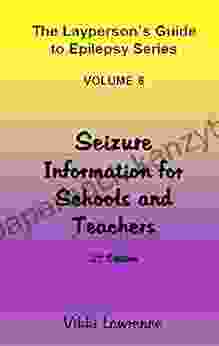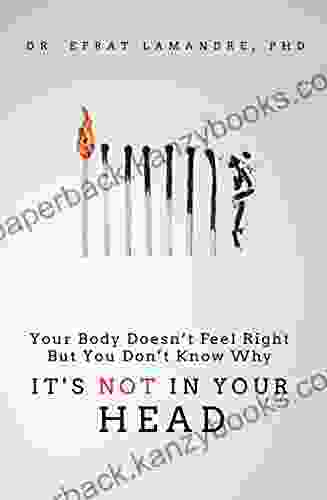Epilepsy: A Layperson's Guide for Schools and Teachers

What is Epilepsy?
Epilepsy is a common neurological disFree Download that can affect people of all ages. It is characterized by recurrent seizures, which are sudden, uncontrolled bursts of electrical activity in the brain. Seizures can vary in severity, from mild to severe.
4.3 out of 5
| Language | : | English |
| File size | : | 720 KB |
| Text-to-Speech | : | Enabled |
| Screen Reader | : | Supported |
| Enhanced typesetting | : | Enabled |
| Word Wise | : | Enabled |
| Print length | : | 49 pages |
Epilepsy is not contagious. It is not caused by mental illness or intellectual disability. Epilepsy is a complex disFree Download that can be caused by a variety of factors, including:
* Head injuries * Brain tumors * Stroke * Infections * Genetic disFree Downloads
What are the Symptoms of Epilepsy?
The symptoms of epilepsy can vary depending on the type of seizure. Some of the most common symptoms include:
* Loss of consciousness * Jerking movements * Staring spells * Confusion * Memory loss * Speech problems * Nausea and vomiting
How is Epilepsy Diagnosed?
Epilepsy is diagnosed based on a patient's history and a physical examination. The doctor may also Free Download one or more of the following tests:
* Electroencephalogram (EEG): An EEG records the electrical activity in the brain. * Magnetic resonance imaging (MRI): An MRI creates detailed images of the brain. * Computed tomography (CT) scan: A CT scan creates cross-sectional images of the brain.
How is Epilepsy Treated?
Epilepsy is treated with medication, surgery, or a combination of both. The goal of treatment is to control seizures and prevent them from recurring.
Medication is the most common treatment for epilepsy. There are a variety of different medications that can be used to treat epilepsy, and the doctor will choose the best medication based on the patient's individual needs.
Surgery may be an option for patients who do not respond to medication. Surgery can be used to remove the part of the brain that is causing the seizures.
What Can Schools and Teachers Do to Help Students with Epilepsy?
Schools and teachers can play an important role in helping students with epilepsy. Here are some tips:
* Be aware of the signs and symptoms of epilepsy. * Create a safe and supportive learning environment for students with epilepsy. * Develop an individualized education plan (IEP) for students with epilepsy. * Administer medication as prescribed by the doctor. * Monitor students with epilepsy for seizures. * Respond to seizures appropriately. * Provide support to students with epilepsy and their families.
Epilepsy is a common neurological disFree Download that can affect people of all ages. It is characterized by recurrent seizures, which are sudden, uncontrolled bursts of electrical activity in the brain. Seizures can vary in severity, from mild to severe.
Epilepsy is not contagious. It is not caused by mental illness or intellectual disability. Epilepsy is a complex disFree Download that can be caused by a variety of factors, including head injuries, brain tumors, stroke, infections, and genetic disFree Downloads.
Epilepsy is diagnosed based on a patient's history and a physical examination. The doctor may also Free Download one or more of the following tests: electroencephalogram (EEG),magnetic resonance imaging (MRI),or computed tomography (CT) scan.
Epilepsy is treated with medication, surgery, or a combination of both. The goal of treatment is to control seizures and prevent them from recurring.
Schools and teachers can play an important role in helping students with epilepsy. By being aware of the signs and symptoms of epilepsy, creating a safe and supportive learning environment, developing an individualized education plan (IEP),administering medication as prescribed by the doctor, monitoring students with epilepsy for seizures, responding to seizures appropriately, and providing support to students with epilepsy and their families, schools and teachers can help students with epilepsy succeed in school.
4.3 out of 5
| Language | : | English |
| File size | : | 720 KB |
| Text-to-Speech | : | Enabled |
| Screen Reader | : | Supported |
| Enhanced typesetting | : | Enabled |
| Word Wise | : | Enabled |
| Print length | : | 49 pages |
Do you want to contribute by writing guest posts on this blog?
Please contact us and send us a resume of previous articles that you have written.
 Book
Book Novel
Novel Page
Page Chapter
Chapter Text
Text Story
Story Genre
Genre Reader
Reader Library
Library Paperback
Paperback E-book
E-book Magazine
Magazine Newspaper
Newspaper Paragraph
Paragraph Sentence
Sentence Bookmark
Bookmark Shelf
Shelf Glossary
Glossary Bibliography
Bibliography Foreword
Foreword Preface
Preface Synopsis
Synopsis Annotation
Annotation Footnote
Footnote Manuscript
Manuscript Scroll
Scroll Codex
Codex Tome
Tome Bestseller
Bestseller Classics
Classics Library card
Library card Narrative
Narrative Biography
Biography Autobiography
Autobiography Memoir
Memoir Reference
Reference Encyclopedia
Encyclopedia Matthew Weiner Md
Matthew Weiner Md Paul Mccarthy
Paul Mccarthy Lewis Shaw
Lewis Shaw Steve Thompson
Steve Thompson Susanna Barkataki
Susanna Barkataki Michelle Grey
Michelle Grey Noah White
Noah White Tatum Spence
Tatum Spence Sonia F Tan
Sonia F Tan Liu Xiaodan
Liu Xiaodan Michael Schwartz
Michael Schwartz Maggie Fitzgerald
Maggie Fitzgerald Petra Bracht
Petra Bracht Todd Nyholm
Todd Nyholm Victor Konshin
Victor Konshin Melanie Salvatore August
Melanie Salvatore August Ryuho Okawa
Ryuho Okawa Matthew Guay
Matthew Guay Lynne Hume
Lynne Hume Robert G Lahita
Robert G Lahita
Light bulbAdvertise smarter! Our strategic ad space ensures maximum exposure. Reserve your spot today!

 Junichiro TanizakiWe Didn't See This Coming: Unveiling the Unforeseen Impacts of Globalization
Junichiro TanizakiWe Didn't See This Coming: Unveiling the Unforeseen Impacts of Globalization Jeffery BellFollow ·10.9k
Jeffery BellFollow ·10.9k Jay SimmonsFollow ·11.5k
Jay SimmonsFollow ·11.5k Pablo NerudaFollow ·9.3k
Pablo NerudaFollow ·9.3k David MitchellFollow ·7k
David MitchellFollow ·7k Victor TurnerFollow ·18.7k
Victor TurnerFollow ·18.7k Art MitchellFollow ·16.8k
Art MitchellFollow ·16.8k John GrishamFollow ·19.3k
John GrishamFollow ·19.3k Chad PriceFollow ·11.6k
Chad PriceFollow ·11.6k

 Tyrone Powell
Tyrone PowellUnlock the Secrets of Consciousness and Infinite...
In the realm of...

 Devin Ross
Devin RossUnlock the Power of Nature: Discover the Transformative...
Embrace a Healthier Tomorrow with...

 Stan Ward
Stan WardUnveiling the Treasures of Pescatarian Cuisine: A...
Are you ready to...

 Edward Bell
Edward BellBreak Free from the Chains of Sexual Addiction: A...
Sexual addiction, a relentless and...

 Wayne Carter
Wayne CarterTantalizing Treats from Paradise: Hawaiian Desserts for...
Embark on a Culinary Journey to the Islands...
4.3 out of 5
| Language | : | English |
| File size | : | 720 KB |
| Text-to-Speech | : | Enabled |
| Screen Reader | : | Supported |
| Enhanced typesetting | : | Enabled |
| Word Wise | : | Enabled |
| Print length | : | 49 pages |












